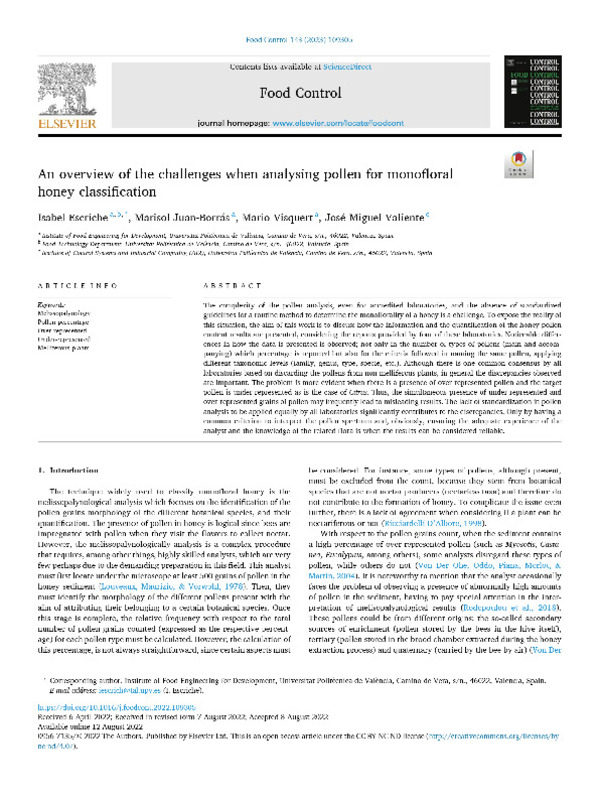JavaScript is disabled for your browser. Some features of this site may not work without it.
Buscar en RiuNet
Listar
Mi cuenta
Estadísticas
Ayuda RiuNet
Admin. UPV
An overview of the challenges when analysing pollen for monofloral honey classification
Mostrar el registro sencillo del ítem
Ficheros en el ítem
| dc.contributor.author | Escriche Roberto, Mª Isabel
|
es_ES |
| dc.contributor.author | Juan-Borras, María del Sol
|
es_ES |
| dc.contributor.author | Visquert Fas, Mario
|
es_ES |
| dc.contributor.author | Valiente González, José Miguel
|
es_ES |
| dc.date.accessioned | 2024-01-08T19:02:55Z | |
| dc.date.available | 2024-01-08T19:02:55Z | |
| dc.date.issued | 2023-01 | es_ES |
| dc.identifier.issn | 0956-7135 | es_ES |
| dc.identifier.uri | http://hdl.handle.net/10251/201621 | |
| dc.description.abstract | [EN] The complexity of the pollen analysis, even for accredited laborat01ies, and the absence of standardized guidelines for a routine method to detennine the monoflorality of a honey is a challenge. To expose the reality of this situation, the aim of this work is to discuss how the info1mation and the quantification of the honey pollen content results are presented, conside1ing the reports provided by four of these laboratoiies. Noticeable differences in how the data is presented is observed; not only in the number of types of pollens (main and accompanying) which percentage is reponed but also for the ciiteria followed in naniing the sanie pollen, applying different taxonomic levels (faniily, genus, type, specie, etc.). Although there is one common consensus by all laboratories based on discarding the pollens from non-melliferous plants, in general the discrepancies obse1ved are important. The problem is more evident when there is a presence of over-represented pollen and die target pollen is under-represented as is the case of Cimis. Thus, the simultaneous presence of under-represented and over-represented grains of pollen may frequently lead to misleading results. The lack of standardization in pollen analysis to be applied equally by all laborat01ies significantly contributes to die discrepancies. Only by having a common cliterion to interpret the pollen specn-um and, obviously, enstung the adequate experience of the analyst and the knowledge of the related flora is when the results can be considered reliable. | es_ES |
| dc.description.sponsorship | The authors are grateful for financial support from the "Ministerio de Ciencia e Innovacion, Agencia Estatal de Investigacion" of Spain under the project PID2019-106800RB-I00 (2019). | es_ES |
| dc.language | Inglés | es_ES |
| dc.publisher | Elsevier | es_ES |
| dc.relation.ispartof | Food Control | es_ES |
| dc.rights | Reconocimiento - No comercial - Sin obra derivada (by-nc-nd) | es_ES |
| dc.subject | Melissopalynology | es_ES |
| dc.subject | Pollen percentage | es_ES |
| dc.subject | Over-represented | es_ES |
| dc.subject | Under-represented | es_ES |
| dc.subject | Melliferous plants | es_ES |
| dc.subject.classification | TECNOLOGIA DE ALIMENTOS | es_ES |
| dc.subject.classification | ARQUITECTURA Y TECNOLOGIA DE COMPUTADORES | es_ES |
| dc.title | An overview of the challenges when analysing pollen for monofloral honey classification | es_ES |
| dc.type | Artículo | es_ES |
| dc.identifier.doi | 10.1016/j.foodcont.2022.109305 | es_ES |
| dc.relation.projectID | info:eu-repo/grantAgreement/AEI/Plan Estatal de Investigación Científica y Técnica y de Innovación 2017-2020/PID2019-106800RB-I00/ES/ANALISIS POLINICO AUTOMATICO EMPLEANDO REDES NEURONALES CONVOLUCIONALES: APLICACION A LA CLASIFICACION MONOFLORAL DE LA MIEL/ | es_ES |
| dc.rights.accessRights | Abierto | es_ES |
| dc.contributor.affiliation | Universitat Politècnica de València. Escola Tècnica Superior d'Enginyeria Informàtica | es_ES |
| dc.contributor.affiliation | Universitat Politècnica de València. Escuela Técnica Superior de Ingeniería Agronómica y del Medio Natural - Escola Tècnica Superior d'Enginyeria Agronòmica i del Medi Natural | es_ES |
| dc.description.bibliographicCitation | Escriche Roberto, MI.; Juan-Borras, MDS.; Visquert Fas, M.; Valiente González, JM. (2023). An overview of the challenges when analysing pollen for monofloral honey classification. Food Control. 143:1-11. https://doi.org/10.1016/j.foodcont.2022.109305 | es_ES |
| dc.description.accrualMethod | S | es_ES |
| dc.relation.publisherversion | https://doi.org/10.1016/j.foodcont.2022.109305 | es_ES |
| dc.description.upvformatpinicio | 1 | es_ES |
| dc.description.upvformatpfin | 11 | es_ES |
| dc.type.version | info:eu-repo/semantics/publishedVersion | es_ES |
| dc.description.volume | 143 | es_ES |
| dc.relation.pasarela | S\491657 | es_ES |
| dc.contributor.funder | AGENCIA ESTATAL DE INVESTIGACION | es_ES |
| dc.contributor.funder | Universitat Politècnica de València |








